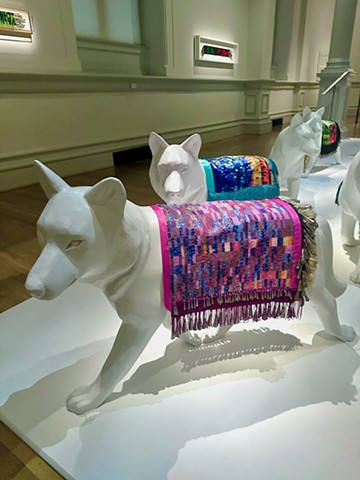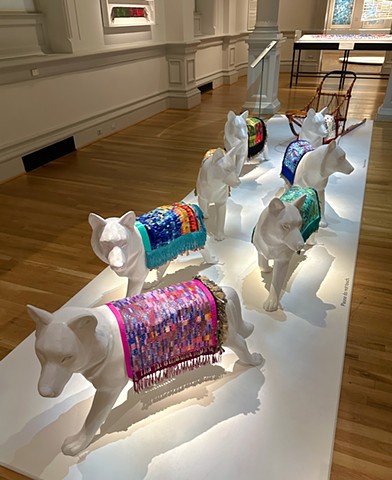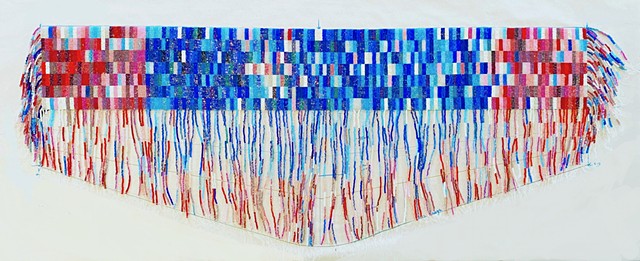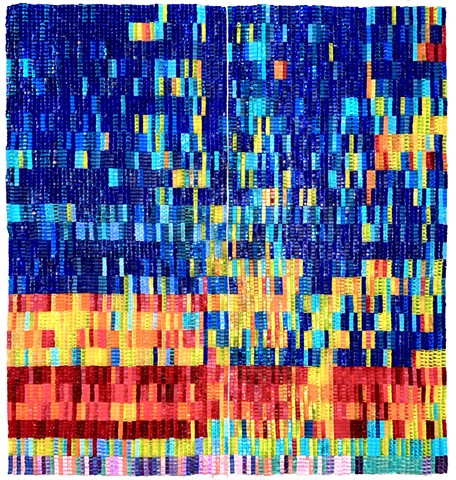The Codes We Carry: Beadwork as DNA Data
The Codes We Carry: Beadwork as DNA Data is a series of beaded sculptures and scanography prints, which combine traditional Indigenous art forms and techniques with DNA/RNA analysis to raise awareness of the health disparities that exist for Native people.
The Codes We Carry is a series of large-scale beaded sculptures that incorporate computer-produced genetic data patterns, or DNA/RNA microarrays, from diseases disproportionately affecting Indigenous communities, and transforms them into loom-woven glass bead burden straps as an act of data sovereignty. Combining these culturally relevant Indigenous art forms and beading techniques with DNA analysis raises awareness of the institutionalized health disparities that exist for Native people.
DNA microarray assays produce color-coded data in a pixel-like format. Each test focuses on a particular disease or condition; the colors and patterns in each test are a reflection of an individual's DNA or RNA in relation to the specific condition and show whether that person has that disease and how much or how advanced it is. I take these tests and replicate the data in beads, using 4mm cube-shaped glass beads, precisely loom-woven, with each glass bead representing a data point.
Scientific conventions used to organize the data correspond well with the dimensions of Alaskan Athabaskan baby belts or burden straps. This customary historical tool from my culture is an ancient technology, allows a person to carry heavy items on their back, hands free. The baby belts represent interpersonal ties and the commitments in the community. Transforming genetic data into a culturally significant form returns this DNA data to the community and makes it tangible and accessible to the marginalized populations it represents.
Sled dog blankets, or “tuppies,” were traditionally beaded blankets with fringe and often bells worn by sled dogs when entering a village during an important or special event. In my series of tuppies, I have incorporated beaded patterns from microarray analyses/tests for diseases that affect Indigenous people disproportionately.
This image shows DNA/RNA Tuppies, or dog blankets, which are displayed on dog forms with a dogsled to help draw a visual connection to the historic 1925 Serum Run, which saved the village of Nome, Alaska, from Diphtheria, which was ravaging the village and killing many people but was killing children in particular, in mass numbers. Due to bad weather, dogsledding was the only way to get the antitoxin to the village. It was brought to my village by train and then handed off from each dog team, over twenty altogether, to finally get the antitoxin to Nome. The films Balto and Togo have memorialized this story in pop culture. I wanted to connect that history to the current pandemic, so I chose diseases that have affected Native people disproportionately, but also ones that we have learned from and created vaccines, like Smallpox or TB. During the Covid-19 pandemic, the effort to distribute vaccines through Alaska was named "Project Togo,” referring to and honoring that historic Serum Run.
This tuppie is carrying the code for Covid-19; the infection rate, as well as the death rate, affected Indigenous people at rates several times more than any other group of people. In the installation, the dogs literally carry the DNA/RNA codes, which are used to first map and understand each condition, which then can lead to the creation of treatments, vaccines, and cures.









